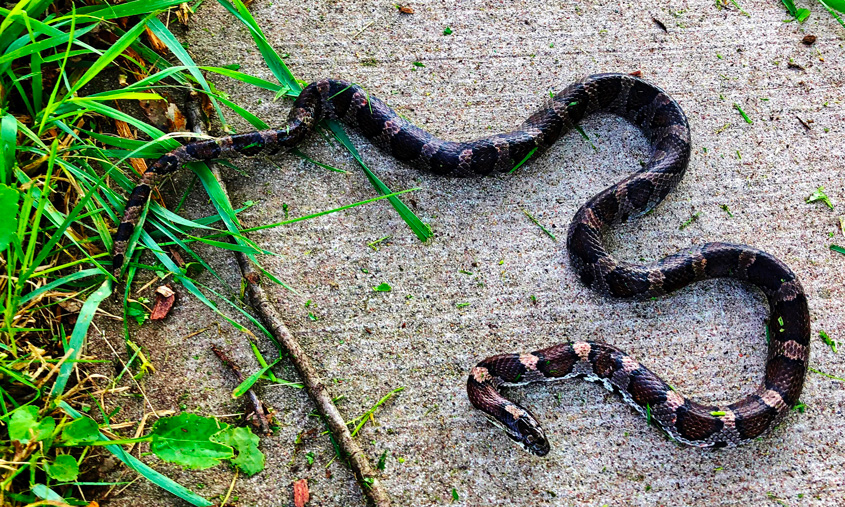Back Home by Chris Hardie
» Download this column as a Word document
» Download the photos that accompany this story
» Chris Hardie’s headshot
Critter encounters are part and parcel with living in the country. They were here before us and will be here after us.
One coiling creature that’s part of the farm is the silent and slithering snake. They mainly keep to themselves but inevitably during the haying season snakes in the field were gathered into a hay bale. There would be tails, heads and snake parts sticking out of the bale — waiting for the first person to pull it out and unexpectedly throw it at someone else.
The garden is another favorite location for snakes. Their appearance means the disappearance of my wife or mother — both of whom are not willing to share their space with what Dad called “slender fellows.” So either Dad or I would move the snake to a different location.

Snakes are beneficial creatures often maligned or misunderstood. They’re friends to farmers; larger snakes eat mice and other grain-eating rodents. The Wisconsin Department of Natural Resources says many snake populations are in decline because of habitat loss and human persecution. Currently there are 21 species of snakes in Wisconsin, of which 14 are considered rare and listed as endangered, threatened or of special concern.
I once unknowingly took a ride to town with a snake in my pickup truck. A few days earlier I noticed a 2-foot-long snake sunning itself on the hood. When I approached the snake dove down through the hood cowling into the engine area.
I drove about 10 miles to Melrose to get gas for the mowers. To check the truck’s oil, I opened the hood. There was a slithering stowaway, wrapped around a non-moving piece of the engine. I could call it my backup serpentine belt.
The snake survived the drive back and a few days later left its calling card — a shed skin on top of the radiator. I think it moved on to a more eco-friendly environment than a 300-cubic-inch six-cylinder.
Recently, I encountered another slender fellow. I had just started to cut grass near the house with a string-trimmer when there was sudden movement. Sure enough, out slithered a slightly annoyed snake about 24 inches long. I stopped to take a photo before I relocated the snake with the aid of a long stick to a safer location out of the trimming zone.
I’m not a herpetologist but after painstaking research that involved a cup of coffee and Google, I have concluded based on the color pattern and size that the snake was either a milksnake or an Eastern Fox Snake — also called a pine snake. Both are common in western Wisconsin.
Milksnakes are 2 to 3 feet long and are often found around farm buildings and older homes. It has a gray or light-brown skin color with reddish-brown or brown blotches bordered with black. They feed on rodents and other small snakes. Because it hangs around barns, it was called a milk snake because legend has it the snake would suck milk from cows.
The other possibility based on the color pattern is the Eastern Fox Snake. But they are normally 3 feet to almost 6 feet in length, although they like to hang around farms because they too enjoy a rodent diet and old buildings.
The DNR says fox snakes are also often mistaken for rattlesnakes because they often “rattle” their tails in dry leaves, grasses or against objects when disturbed. Their pointed tail distinguishes them — and all other Wisconsin snakes with pointed tails — as a non-venomous species in Wisconsin. They produce a musky odor similar to that of the red fox when handled, hence their common name “fox snake.”
Fox snakes are constrictors, grabbing prey with their teeth and wrapping themselves around it to stop its breathing before swallowing it whole. But fox snakes don’t hatch until late August and are about a foot long at birth, so the timing doesn’t match my sighting.
But a third candidate emerged after a third cup of coffee and some additional keystrokes — the Eastern hognosed snake. They are also common in my neck of the woods. The color pattern is similar and the size is right — 20 to 35 inches — but the head seemed a little too small.
My vote is for the milksnake. This was a dairy farm for many years, after all. No matter what species it was, I wish the serpent and all its slithering associates all the best — and please practice social distancing.
Chris Hardie spent more than 30 years as a reporter, editor



